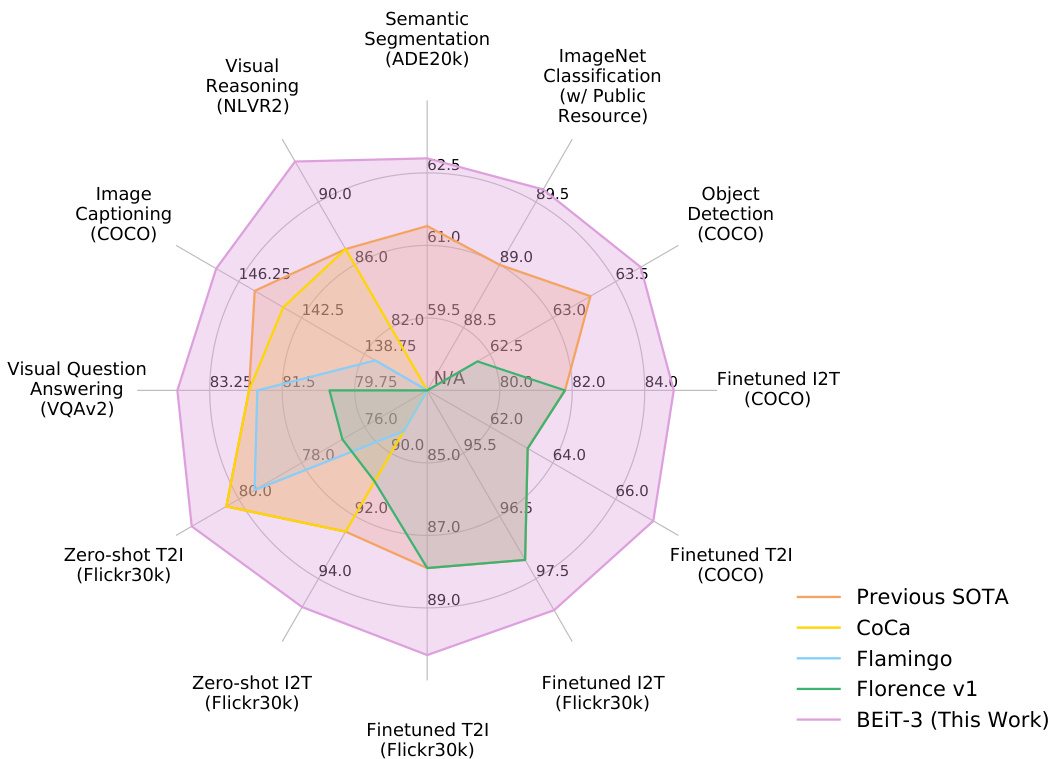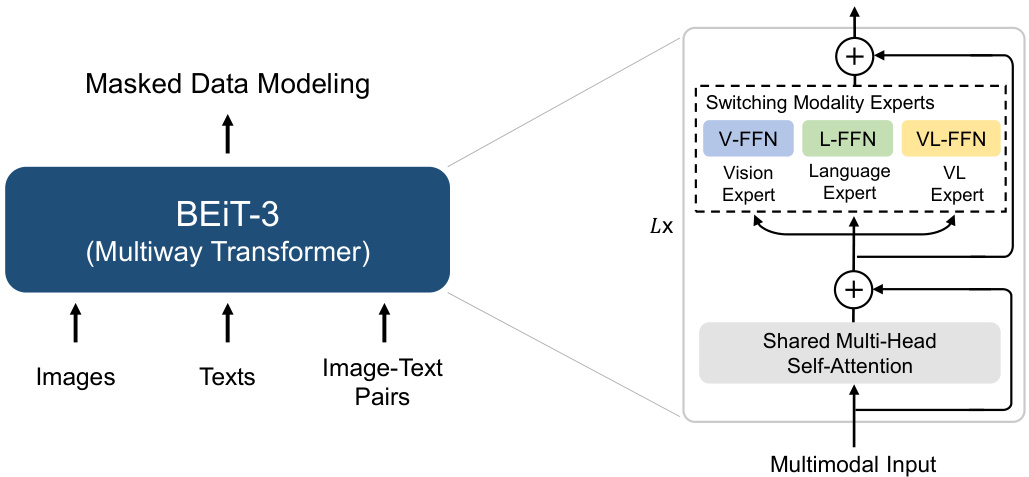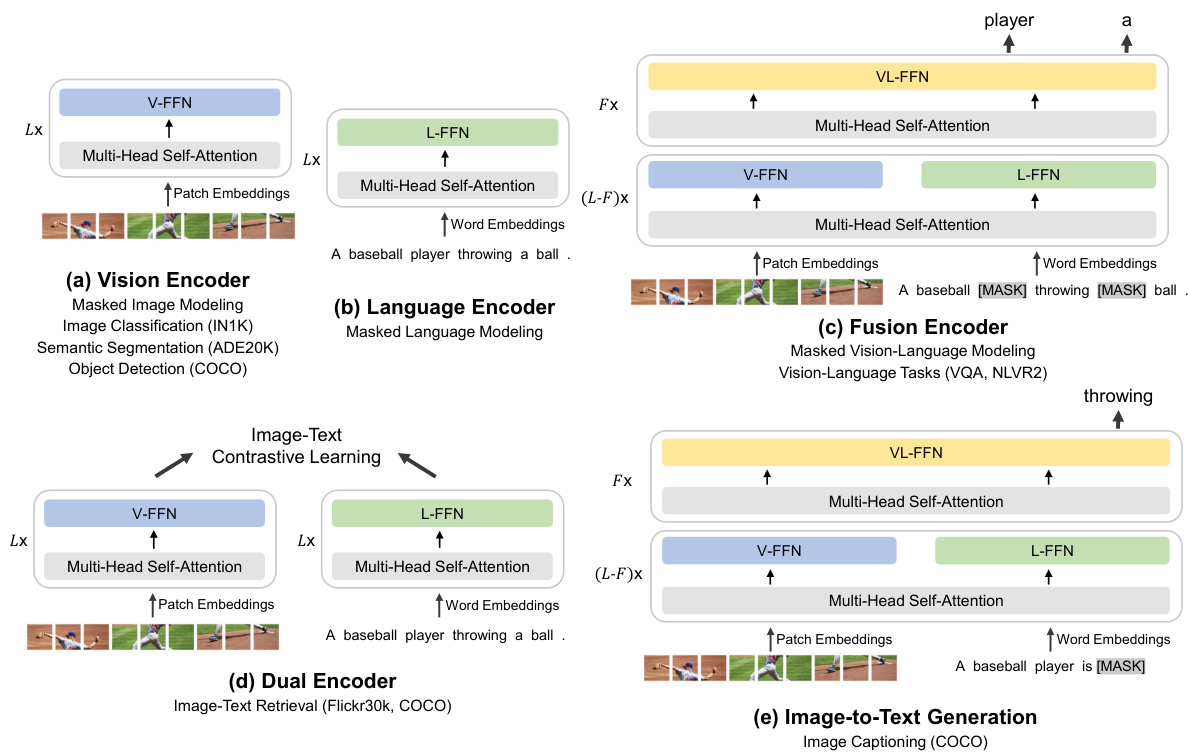Image as a Foreign Language: BEIT Pre training for All Vision and Vision-Language Tasks
图像作为外语:面向所有视觉与视觉-语言任务的BEIT预训练
Abstract
摘要
A big convergence of language, vision, and multimodal pre training is emerging. In this work, we introduce a general-purpose multimodal foundation model BEIT-3, which achieves state-of-the-art transfer performance on both vision and visionlanguage tasks. Specifically, we advance the big convergence from three aspects: backbone architecture, pre training task, and model scaling up. We introduce Multiway Transformers for general-purpose modeling, where the modular architecture enables both deep fusion and modality-specific encoding. Based on the shared backbone, we perform masked “language” modeling on images (Imglish), texts (English), and image-text pairs (“parallel sentences”) in a unified manner. Experimental results show that BEIT-3 obtains state-of-the-art performance on object detection (COCO), semantic segmentation (ADE20K), image classification (ImageNet), visual reasoning (NLVR2), visual question answering (VQAv2), image captioning (COCO), and cross-modal retrieval (Flickr30K, COCO).
语言、视觉和多模态预训练的大融合正在兴起。本文提出了一种通用多模态基础模型BEIT-3,在视觉和视觉-语言任务上均实现了最先进的迁移性能。具体而言,我们从三个维度推进大融合:主干架构、预训练任务和模型扩展。我们引入了通用建模的多路Transformer (Multiway Transformers),其模块化架构同时支持深度融合和模态专用编码。基于共享主干网络,我们以统一方式对图像(Imglish)、文本(English)和图文对("平行句")进行掩码"语言"建模。实验结果表明,BEIT-3在目标检测(COCO)、语义分割(ADE20K)、图像分类(ImageNet)、视觉推理(NLVR2)、视觉问答(VQAv2)、图像描述(COCO)和跨模态检索(Flickr30K, COCO)等任务上均取得最先进性能。

Figure 1: BEIT-3 achieves state-of-the-art performance on a broad range of tasks compared with other customized or foundation models. I2T/T2I is short for image-to-text/text-to-image retrieval.
图 1: BEIT-3 在广泛任务上相比其他定制或基础模型实现了最先进的性能。I2T/T2I 是图像到文本/文本到图像检索的缩写。
| 类别 | 任务 | 数据集 | 指标 | 先前SOTA | BE1T-3 |
|---|---|---|---|---|---|
| 视觉 | 语义分割 | ADE20K | mIoU | 61.4 (FD-SwinV2) | 62.8 (+1.4) |
| 目标检测 | COCO | AP | 63.3 (DINO) | 63.7 (+0.4) | |
| 实例分割 | COCO | AP | 54.7 (Mask DINO) | 54.8 (+0.1) | |
| 图像分类 | ImageNet | Top-1准确率 | 89.0 (FD-CLIP) | 89.6 (+0.6) | |
| 视觉-语言 | 视觉推理 | NLVR2 | 准确率 | 87.0 (CoCa) | 92.6 (+5.6) |
| 视觉问答 | VQAv2 | VQA准确率 | 82.3 (CoCa) | 84.0 (+1.7) | |
| 图像描述生成 | COCO | CIDEr | 145.3 (OFA) | 147.6 (+2.3) | |
| 微调检索 | COCO Flickr30K | R@1 | 72.5 (Florence) 92.6 (Florence) | 76.0 (+3.5) 94.2 (+1.6) | |
| 零样本检索 | Flickr30K | R@1 | 86.5 (CoCa) | 88.2 (+1.7) |
Table 1: Overview of BEIT-3 results on various vision and vision-language benchmarks. We compare with previous state-of-the-art models, including FD-SwinV2 $[\mathbf{W}\mathbf{H}\bar{\mathbf{X}}^{+}22]$ , DINO $[\mathrm{ZLL^{+}}22]$ ], Mask DINO $[\mathrm{ZLL^{+}}22]$ , FD-CLIP $[\mathbf{W}\mathbf{H}\mathbf{X}^{+}22]$ , CoCa $\mathbf{\bar{[}Y W V^{+}22]}$ , OFA $[\mathbf{W}\mathbf{Y}\mathbf{M}^{+}22]$ , Florence $[\mathrm{YCC}^{+}21]$ . We report the average of top-1 image-to-text and text-to-image results for retrieval tasks. “†” indicates ImageNet results only using publicly accessible resources. $\yen123,456$ indicates image captioning results without CIDEr optimization.
表 1: BEIT-3 在各种视觉与视觉语言基准测试中的结果概览。我们与包括 FD-SwinV2 $[\mathbf{W}\mathbf{H}\bar{\mathbf{X}}^{+}22]$、DINO $[\mathrm{ZLL^{+}}22]$、Mask DINO $[\mathrm{ZLL^{+}}22]$、FD-CLIP $[\mathbf{W}\mathbf{H}\mathbf{X}^{+}22]$、CoCa $\mathbf{\bar{[}Y W V^{+}22]}$、OFA $[\mathbf{W}\mathbf{Y}\mathbf{M}^{+}22]$、Florence $[\mathrm{YCC}^{+}21]$ 在内的先前最先进模型进行了比较。对于检索任务,我们报告了图像到文本和文本到图像检索结果的 top-1 平均值。"†"表示仅使用公开可访问资源的 ImageNet 结果。$\yen123,456$ 表示未经 CIDEr 优化的图像描述结果。
1 Introduction: The Big Convergence
1 引言:大融合
Recent years have featured a trend toward the big convergence of language [RNSS18, DCLT19, $\mathrm{DYW^{+}i9]}$ , vision [BDPW22, $\mathrm{PDB}^{+}22]$ , and multimodal [WBDW21, $\mathrm{RKH^{+}}21$ , $\mathrm{YWV}^{+}22]$ pretraining. By performing large-scale pre training on massive data, we can easily transfer the models to various downstream tasks. It is appealing that we can pretrain a general-purpose foundation model that handles multiple modalities. In this work, we advance the convergence trend for vision-language pre training from the following three aspects.
近年来,语言 [RNSS18, DCLT19, $\mathrm{DYW^{+}i9]}$、视觉 [BDPW22, $\mathrm{PDB}^{+}22]$ 以及多模态 [WBDW21, $\mathrm{RKH^{+}}21$, $\mathrm{YWV}^{+}22]$ 预训练呈现出大融合趋势。通过对海量数据进行大规模预训练,我们可以轻松将模型迁移至各类下游任务。预训练一个能处理多模态的通用基础模型 (foundation model) 极具吸引力。本工作从以下三个方面推进了视觉语言预训练的融合趋势。
First, the success of Transformers $[\mathrm{VSP^{+}}17]$ is translated from language to vision $[\mathrm{DBK^{+}}20]$ and multimodal [KSK21, WBDW21] problems. The unification of network architectures enables us to seamlessly handle multiple modalities. For vision-language modeling, there are various ways to apply Transformers due to the different natures of downstream tasks. For example, the dual-encoder architecture is used for efficient retrieval $[\mathrm{RKH^{+}}21]$ , encoder-decoder networks for generation tasks $[\mathbf{WYY^{+}}21]$ , and the fusion-encoder architecture for image-text encoding [KSK21]. However, most foundation models have to manually convert the end-task formats according to the specific architectures. Moreover, the parameters are usually not effectively shared across modalities. In this work, we adopt Multiway Transformers [WBDW21] for general-purpose modeling, i.e., one unified architecture shared for various downstream tasks. The modular network also comprehensively considers modality-specific encoding and cross-modality fusion.
首先,Transformer [VSP+17] 的成功从语言领域扩展到视觉 [DBK+20] 和多模态 [KSK21, WBDW21] 问题。网络架构的统一使我们能够无缝处理多种模态。针对视觉-语言建模,由于下游任务性质不同,存在多种应用Transformer的方式。例如:双编码器架构用于高效检索 [RKH+21],编码器-解码器网络用于生成任务 [WYY+21],融合编码器架构用于图文编码 [KSK21]。然而,大多数基础模型仍需根据特定架构手动转换终端任务格式。此外,参数通常无法跨模态有效共享。本文采用多路Transformer [WBDW21] 进行通用建模,即通过单一统一架构处理各类下游任务。该模块化网络还全面考虑了模态特定编码与跨模态融合。
Second, the pre training task based on masked data modeling has been successfully applied to various modalities, such as texts [DCLT19], images [BDPW22, $\mathrm{PD}\bar{\mathbf{B}}^{+}22]$ ], and image-text pairs [BWDW22]. Current vision-language foundation models usually multitask other pre training objectives (such as image-text matching), rendering scaling-up unfriendly and inefficient. In contrast, we only use one pre training task, i.e., mask-then-predict, to train a general-purpose multimodal foundation model. By regarding the image as a foreign language (i.e., Imglish), we handle texts and images in the same manner without fundamental modeling differences. Con sequentially, image-text pairs are utilized as “parallel sentences” in order to learn the alignments between modalities. We also show that the simple yet effective method learns strong transferable representations, achieving state-of-the-art performance on both vision and vision-language tasks. The prominent success demonstrates the superiority of generative pre training [DCLT19, BDPW22].
其次,基于掩码数据建模的预训练任务已成功应用于多种模态,如文本 [DCLT19]、图像 [BDPW22, $\mathrm{PD}\bar{\mathbf{B}}^{+}22$] 以及图文对 [BWDW22]。当前的视觉-语言基础模型通常需要多任务处理其他预训练目标(如图文匹配),导致扩展不友好且效率低下。相比之下,我们仅使用一种预训练任务(即掩码预测)来训练通用多模态基础模型。通过将图像视为外语(即 Imglish),我们以相同方式处理文本和图像,无需根本性建模差异。因此,图文对被用作“平行句子”以学习模态间的对齐。我们还证明,这种简单而有效的方法能学习到强可迁移表征,在视觉和视觉-语言任务上均达到最先进性能。这一显著成功证明了生成式预训练 [DCLT19, BDPW22] 的优越性。
Third, scaling up the model size and data size universally improves the generalization quality of foundation models, so that we can transfer them to various downstream tasks. We follow the philosophy and scale up the model size to billions of parameters. Moreover, we scale up the pre training data size in our experiments while only using publicly accessible resources for academic reproducibility. Although without using any private data, our method outperforms state-of-the-art foundation models that rely on in-house data by a decent margin. In addition, the scaling up benefits from treating images as a foreign language, as we can directly reuse the pipeline developed for large-scale language model pre training.
第三,扩大模型规模和数据规模普遍提升了基础模型的泛化能力,使其能够迁移到各种下游任务中。我们遵循这一理念,将模型参数量级提升至数十亿。同时,在实验中仅使用公开可获取资源以保证学术可复现性的前提下,我们大幅增加了预训练数据规模。尽管未使用任何私有数据,我们的方法仍以明显优势超越了依赖内部数据的最先进基础模型。此外,这种规模化优势得益于将图像视为"外语"的处理方式——这使我们能直接复用为大语言模型预训练开发的流程。

Figure 2: Overview of BEIT-3 pre training. We perform masked data modeling on monomodal (i.e., images, and texts) and multimodal (i.e., image-text pairs) data with a shared Multiway Transformer as the backbone network.
图 2: BEIT-3预训练概述。我们使用共享的Multiway Transformer作为骨干网络,在单模态(即图像和文本)和多模态(即图文对)数据上执行掩码数据建模。
In this work, we take advantage of the above ideas to pretrain a general-purpose multimodal foundation model BEIT-3. We pretrain a Multiway Transformer by performing masked data modeling on images, texts, and image-text pairs. During pre training, we randomly mask some proportion of text tokens or image patches. The self-supervised learning objective is to recover the original tokens (i.e., text tokens, or visual tokens) given corrupted inputs. The model is general-purpose in the sense that it can be repurposed for various tasks regardless of input modalities, or output formats.
在本工作中,我们利用上述思想预训练了一个通用多模态基础模型BEIT-3。我们通过对图像、文本和图文对进行掩码数据建模,预训练了一个多路Transformer。在预训练期间,我们随机掩码一定比例的文本token或图像块。自监督学习的目标是根据损坏的输入恢复原始token(即文本token或视觉token)。该模型的通用性体现在:无论输入模态或输出格式如何,它都能适应各种任务。
2 BEIT-3: A General-Purpose Multimodal Foundation Model
2 BEIT-3: 通用多模态基础模型
As shown in Figure 2, BEIT-3 is pretrained by masked data modeling on monomodal and multimodal data, using a shared Multiway Transformer network. The model can be transferred to various vision and vision-language downstream tasks.
如图 2 所示,BEIT-3 通过单模态和多模态数据的掩码数据建模 (masked data modeling) 进行预训练,使用共享的多路 Transformer (Multiway Transformer) 网络。该模型可迁移至各类视觉和视觉-语言下游任务。
2.1 Backbone Network: Multiway Transformers
2.1 主干网络:多路Transformer
We use Multiway Transformers [WBDW21] as the backbone model to encode different modalities. As shown in Figure 2, each Multiway Transformer block consists of a shared self-attention module, and a pool of feed-forward networks (i.e., modality experts) used for different modalities. We route each input token to the experts depending on its modality. In our implementation, each layer contains a vision expert and a language expert. Moreover, the top three layers have vision-language experts designed for fusion encoders. Refer to Figure 3 (a)(b)(c) for more detailed modeling layouts. Using a pool of modality experts encourages the model to capture more modality-specific information. The shared self-attention module learns the alignment between different modalities and enables deep fusion for multimodal (such as vision-language) tasks.
我们采用Multiway Transformer [WBDW21]作为主干模型来编码不同模态。如图2所示,每个Multiway Transformer块包含一个共享的自注意力模块,以及一组用于不同模态的前馈网络(即模态专家)。我们根据每个输入token的模态将其路由到相应的专家模块。在具体实现中,每层包含一个视觉专家和一个语言专家。此外,顶层三个层还设有专为融合编码器设计的视觉-语言专家。更详细的建模布局请参见图3(a)(b)(c)。通过使用模态专家池,模型能够更好地捕捉特定模态的信息。共享的自注意力模块则学习不同模态间的对齐关系,并为多模态(如视觉-语言)任务实现深度融合。

Figure 3: BEIT-3 can be transferred to various vision and vision-language downstream tasks. With a shared Multiway Transformer, we can reuse the model as (a)(b) vision or language encoders; (c) fusion encoders that jointly encode image-text pairs for deep interaction; (d) dual encoders that separately encode modalities for efficient retrieval; (e) sequence-to-sequence learning for image-totext generation.
图 3: BEIT-3 可迁移至多种视觉及视觉-语言下游任务。通过共享的多路 Transformer (Multiway Transformer),我们可以将模型复用为:(a)(b) 视觉或语言编码器;(c) 融合编码器(联合编码图文对以实现深度交互);(d) 双编码器(分别编码不同模态以实现高效检索);(e) 序列到序列学习(用于图像到文本生成)。
As shown in Figure 3, the unified architecture enables BEIT-3 to support a wide range of downstream tasks. For example, BEIT-3 can be used as an image backbone for various vision tasks, including image classification, object detection, instance segmentation, and semantic segmentation. It can also be finetuned as a dual encoder for efficient image-text retrieval, and a fusion model for multimodal understanding and generation tasks.
如图 3 所示,统一架构使 BEIT-3 能够支持广泛的下游任务。例如,BEIT-3 可作为各类视觉任务的图像主干网络,包括图像分类、目标检测、实例分割和语义分割。它还能微调为高效的图文检索双编码器,或用于多模态理解与生成任务的融合模型。
2.2 Pre training Task: Masked Data Modeling
2.2 预训练任务:掩码数据建模 (Masked Data Modeling)
We pretrain BEIT-3 via a unified masked data modeling [BWDW22] objective on monomodal (i.e., images, and texts) and multimodal data (i.e., image-text pairs). During pre training, we randomly mask some percentage of text tokens or image patches and train the model to recover the masked tokens. The unified mask-then-predict task not only learns representations but also learns the alignment of different modalities. Specifically, text data is tokenized by a Sentence Piece tokenizer [KR18]. Image data is tokenized by the tokenizer of BEIT v2 $[\mathrm{PDB^{+}}2\dot{2}]$ ] to obtain the discrete visual tokens as the reconstructed targets. We randomly mask $15%$ tokens of monomodal texts and $50%$ tokens of texts from image-text pairs. For images, we mask $40%$ of image patches using a block-wise masking strategy as in BEIT [BDPW22, $\bar{\mathrm{PDB}}^{+}22^{\cdot}$ ].
我们通过统一的掩码数据建模 [BWDW22] 目标在单模态(即图像和文本)和多模态数据(即图文对)上预训练 BEIT-3。在预训练过程中,我们随机掩码一定比例的文本 token 或图像块,并训练模型恢复被掩码的 token。这种统一的"掩码-预测"任务不仅学习表征,还学习不同模态的对齐。具体而言,文本数据通过 Sentence Piece tokenizer [KR18] 进行 token 化,图像数据则通过 BEIT v2 的 tokenizer $[\mathrm{PDB^{+}}2\dot{2}]$ 获得离散视觉 token 作为重建目标。我们随机掩码单模态文本中 $15%$ 的 token 和图文对中文本的 $50%$ token。对于图像,我们采用 BEIT [BDPW22, $\bar{\mathrm{PDB}}^{+}22^{\cdot}$] 中的分块掩码策略掩码 $40%$ 的图像块。
We only use one pre training task, which makes the training process scaling-up friendly. In contrast, previous vision-language models $[\mathrm{LYL^{+}}20$ , $\mathrm{ZLH^{+}}2\mathrm{i}$ , KSK21, $\mathrm{LS}\bar{\mathrm{G}}^{+}\bar{2}1$ , WBDW21, LLXH22, usually employ multiple pre training tasks, such as image-text contrast, imagetext matching, and word-patch/region alignment. We show that a much smaller pre training batch size can be used with the mask-then-predict task. In comparison, contrastive-based models $[\mathrm{RKH^{+}}21$ , $\mathbf{J}\mathbf{Y}\mathbf{X}^{+}21$ , $\mathrm{YCC}^{+}21$ , $\mathrm{YWV}^{+}2\bar{2}\mathrm{]}$ usually need a very large batch size2 for pre training, which brings more engineering challenges, such as GPU memory cost.
我们仅采用一种预训练任务,这使得训练过程更易于扩展。相比之下,以往的视觉语言模型 [LYL+20, ZLH+21, KSK21, LSG+21, WBDW21, LLXH22, ΔYWV+22] 通常采用多种预训练任务,如图文对比 (image-text contrast) 、图文匹配 (image-text matching) 和词块/区域对齐 (word-patch/region alignment) 。我们证明掩码预测任务 (mask-then-predict) 可以使用更小的预训练批次规模。而基于对比的模型 [RKH+21, JYX+21, YCC+21, YWV+22] 通常需要非常大的预训练批次规模,这会带来更多工程挑战,例如 GPU 内存开销。
Table 2: Model configuration of BEIT-3. The architecture layout follows ViT-giant [ZKHB21].
表 2: BEIT-3的模型配置。架构布局遵循ViT-giant [ZKHB21]。
| Model | #Layers | Hidden Size | MLP Size | V-FFN | L-FFN | VL-FFN | Shared Attention | Total |
|---|---|---|---|---|---|---|---|---|
| BE1T-3 | 40 | 1408 | 6144 | 692M | 692M | 52M | 317M | 1.9B |
Table 3: Pre training data of BEIT-3. All the data are academically accessible.
| 数据 | 来源 | 规模 |
|---|---|---|
| 图文对 (Image-Text Pair) | CC12M、CC3M、SBU、C0CO、VG | 2100万组 |
| 图像 (Image) | ImageNet-21K | 1400万张 |
| 文本 (Text) | 英文维基百科、BookCorpus、Open WebText、CC-News、Stories | 160GB文档 |
表 3: BEIT-3的预训练数据。所有数据均可在学术领域公开获取。
2.3 Scaling Up: BEIT-3 Pre training
2.3 规模化:BEIT-3 预训练
Backbone Network BEIT-3 is a giant-size foundation model following the setup of ViTgiant [ZKHB21]. As shown in Table 2, the model consists of a 40-layer Multiway Transformer with 1408 hidden size, 6144 intermediate size, and 16 attention heads. All layers contain both vision experts and language experts. Vision-language experts are also employed in the top three Multiway Transformer layers. The self-attention module is shared across different modalities. BEIT-3 consists of 1.9B parameters in total, including 692M parameters for vision experts, 692M parameters for language experts, 52M parameters for vision-language experts, and 317M parameters for the shared self-attention module. Notice that only vision-related parameters (i.e., comparable size as ViT-giant; about 1B) are activated when the model is used as a vision encoder.
骨干网络
BEIT-3 是一个遵循 ViTgiant [ZKHB21] 架构设计的超大规模基础模型。如表 2 所示,该模型由 40 层 Multiway Transformer 组成,隐藏层维度为 1408,中间层维度为 6144,并配备 16 个注意力头。所有层均包含视觉专家模块和语言专家模块,其中顶层三个 Multiway Transformer 层还引入了视觉-语言联合专家模块。自注意力模块在不同模态间共享。BEIT-3 总参数量达 19 亿,包含 6.92 亿视觉专家参数、6.92 亿语言专家参数、5200 万视觉-语言专家参数以及 3.17 亿共享自注意力模块参数。需注意的是,当模型作为视觉编码器使用时,仅激活视觉相关参数(即与 ViT-giant 相当的约 10 亿参数)。
表 2:
Pre training Data BEIT-3 is pretrained on both monomodal and multimodal data shown in Table 3. For multimodal data, there are about 15M images and 21M image-text pairs collected from five public datasets: Conceptual 12M (CC12M) [CSDS21], Conceptual Captions (CC3M) [SDGS18], SBU Captions (SBU) [OKB11], COCO $[\mathrm{LMB^{+}}14]$ and Visual Genome (VG) $[\mathrm{KZG^{+}}17]$ . For monomodal data, we use 14M images from ImageNet-21K and 160GB text corpora $[\mathrm{BDW}^{+}20]$ from English Wikipedia, BookCorpus $[Z\mathrm{K}Z^{+}15]$ , Open Web Text 3, CC-News $\mathrm{[LOG^{+}19]}$ , and Stories [TL18].
预训练数据
BEIT-3 在表 3 所示的单模态和多模态数据上进行预训练。多模态数据包含约 1500 万张图像和 2100 万图文对,采集自五个公开数据集:Conceptual 12M (CC12M) [CSDS21]、Conceptual Captions (CC3M) [SDGS18]、SBU Captions (SBU) [OKB11]、COCO [LMB+14] 和 Visual Genome (VG) [KZG+17]。单模态数据包含 ImageNet-21K 的 1400 万张图像,以及来自英文维基百科、BookCorpus [ZKZ+15]、Open Web Text 3、CC-News [LOG+19] 和 Stories [TL18] 的 160GB 文本语料 [BDW+20]。
Pre training Settings We pretrain BEIT-3 for 1M steps. Each batch contains 6144 samples in total, including 2048 images, 2048 texts and 2048 image-text pairs. The batch size is much smaller than contrastive models $[\mathrm{RKH^{+}}21$ , $\mathrm{JYX^{+}}21$ , $\mathrm{YWV}^{+}22]$ . BEIT-3 uses $14\times14$ patch size and is pretrained at resolution $224\times224$ . We use the same image augmentation as in BEIT [BDPW22], including random resized cropping, horizontal flipping, and color jittering [WXYL18]. A SentencePiece tokenizer [KR18] with 64k vocab size is employed to tokenize the text data. We use the AdamW [LH19] optimizer with $\beta_{1}=0.9$ , $\beta_{2}=0.98$ and $\epsilon=1\mathrm{e}{-6}$ for optimization. We use a cosine learning rate decay scheduler with a peak learning rate of 1e-3 and a linear warmup of 10k steps. The weight decay is 0.05. Stochastic depth $[\mathrm{HSL^{+}}1\bar{6}]$ with a rate of 0.1 is used. The BEiT initialization algorithm4 [BDPW22] is used to stabilize Transformer training.
预训练设置
我们预训练BEIT-3共100万步。每批次包含6144个样本,其中2048张图像、2048段文本和2048个图文对。该批次规模远小于对比模型 $[\mathrm{RKH^{+}}21$, $\mathrm{JYX^{+}}21$, $\mathrm{YWV}^{+}22]$。BEIT-3采用 $14\times14$ 的块大小,并在 $224\times224$ 分辨率下进行预训练。我们使用与BEIT [BDPW22]相同的图像增强方法,包括随机缩放裁剪、水平翻转和色彩抖动 [WXYL18]。文本数据采用词汇量为64k的SentencePiece tokenizer [KR18]进行分词。优化器选用AdamW [LH19],参数设为 $\beta_{1}=0.9$, $\beta_{2}=0.98$ 和 $\epsilon=1\mathrm{e}{-6}$。学习率调度采用余弦衰减,峰值学习率为1e-3,并配合10k步的线性预热。权重衰减为0.05。使用随机深度 $[\mathrm{HSL^{+}}1\bar{6}]$,比例为0.1。通过BEiT初始化算法4 [BDPW22]来稳定Transformer训练。
3 Experiments on Vision and Vision-Language Tasks
3 视觉与视觉-语言任务实验
We extensively evaluate BEIT-3 on major public benchmarks for both vision-language and vision tasks. Table 1 presents the overview of results. BEIT-3 obtains state-of-the-art performance on a wide range of vision and vision-language tasks.
我们在视觉语言和视觉任务的主要公共基准上对BEIT-3进行了广泛评估。表1展示了结果概览。BEIT-3在广泛的视觉和视觉语言任务中取得了最先进的性能。
Table 4: Results of visual question answering, visual reasoning, and image captioning tasks. We report vqa-score on VQAv2 test-dev and test-standard splits, accuracy for NLVR2 development set and public test set (test-P). For COCO image captioning, we report BLEU $\ @4$ $(\mathrm{B}@4)$ , METEOR (M), CIDEr (C), and SPICE (S) on the Karpathy test split. For simplicity, we report captioning results without using CIDEr optimization.
表 4: 视觉问答、视觉推理和图像描述任务的结果。我们在 VQAv2 的 test-dev 和 test-standard 划分上报告 vqa-score,在 NLVR2 开发集和公开测试集 (test-P) 上报告准确率。对于 COCO 图像描述任务,我们在 Karpathy 测试划分上报告 BLEU $\ @4$ $(\mathrm{B}@4)$、METEOR (M)、CIDEr (C) 和 SPICE (S)。为简化起见,我们报告的描述结果未使用 CIDEr 优化。
| 模型 | VQAv2 test-dev | VQAv2 test-std | NLVR2 dev | NLVR2 test-P | COCO Captioning B@4 | COCO Captioning M | COCO Captioning C | COCO Captioning S |
|---|---|---|---|---|---|---|---|---|
| Oscar [LYL+20] | 73.61 | 73.82 | 79.12 | 80.37 | 37.4 | 30.7 | 127.8 | 23.5 |
| VinVL [ZLH+21] | 76.52 | 76.60 | 82.67 | 83.98 | 38.5 | 30.4 | 130.8 | 23.4 |
| ALBEF [LSG+21] | 75.84 | 76.04 | 82.55 | 83.14 | ||||
| BLIP [LLXH22] | 78.25 | 78.32 | 82.15 | 82.24 | 40.4 | 136.7 | ||
| SimVLM [WYY+21] | 80.03 | 80.34 | 84.53 | 85.15 | 40.6 | 33.7 | 143.3 | 25.4 |
| Florence [YCC+21] | 80.16 | 80.36 | ||||||
| OFA [WYM+22] | 82.00 | 82.00 | 43.9 | 31.8 | 145.3 | 24.8 | ||
| Flamingo [ADL+22] | 82.00 | 82.10 | 138.1 | |||||
| CoCa [YWV+22] | 82.30 | 82.30 | 86.10 | 87.00 | 40.9 | 33.9 | 143.6 | 24.7 |
| BE1T-3 | 84.19 | 84.03 | 91.51 | 92.58 | 44.1 | 32.4 | 147.6 | 25.4 |
3.1 Vision-Language Downstream Tasks
3.1 视觉语言下游任务
We evaluate the capabilities of BEIT-3 on the widely used vision-language understanding and generation benchmarks, including visual question answering $[\mathrm{GKS^{+}}17]$ , visual reasoning $[\mathrm{SZ}\bar{Z}^{+}19]$ , image-text retrieval $\mathrm{[PWC^{+}}15$ , $\bar{\mathrm{LMB}}^{+}1\bar{4}\bar{]}$ , and image captioning $[\mathrm{LMB^{+}}14]$ .
我们在广泛使用的视觉语言理解和生成基准上评估BEIT-3的能力,包括视觉问答 $[\mathrm{GKS^{+}}17]$ 、视觉推理 $[\mathrm{SZ}\bar{Z}^{+}}19]$ 、图文检索 $\mathrm{[PWC^{+}}15$ 和 $\bar{\mathrm{LMB}}^{+}1\bar{4}\bar{]}$ ,以及图像描述 $[\mathrm{LMB^{+}}14]$ 。
Visual Question Answering (VQA) The task requires the model to answer natural language questions about input images. Following previous work $[\mathrm{AHB^{+}}18$ , $\mathrm{ZLH^{+}21}$ , KSK21], we conduct finetuning experiments on the VQA $\mathrm{v}2.0$ dataset $[\mathrm{GKS^{+}}17]$ and formulate the task as a classification problem. The model is trained to predict answers from the 3129 most frequent answer candidates in the training set. BEIT-3 is finetuned as a fusion encoder to model deep interactions of images and questions for the VQA task. We concatenate the embeddings of a given question and an image, and then feed the input embeddings into Multiway Transformers to jointly encode the image-question pair. The final pooled output is fed into a classifier layer to predict the answer. The results are present in Table 4, BEIT-3 outperforms all previous models by a large margin (more than 1.7 points), pushing the state of the art to 84.03 with a single model.
视觉问答 (Visual Question Answering, VQA)
该任务要求模型回答关于输入图像的自然语言问题。遵循先前工作 [AHB+18, ZLH+21, KSK21],我们在 VQA v2.0 数据集 [GKS+17] 上进行了微调实验,并将该任务定义为分类问题。模型被训练用于从训练集中 3129 个最常见候选答案中预测答案。BEIT-3 作为融合编码器进行微调,以建模图像和问题在 VQA 任务中的深度交互。我们将给定问题和图像的嵌入向量拼接后,输入到 Multiway Transformer 中联合编码图像-问题对。最终的池化输出被送入分类层以预测答案。结果如 表 4 所示,BEIT-3 以显著优势(超过 1.7 分)超越所有先前模型,将单模型性能推升至 84.03,刷新了当前最优水平。
Visual Reasoning The task needs models to perform joint reasoning about images and natural language descriptions. We evaluate the model on the popular NLVR2 $[\bar{\mathrm{SZZ^{+}}}19]$ benchmark, which is to determine whether a textual description is true about a pair of images. Following previous work $[\mathrm{ZLH^{+}}21$ , KSK21], we construct two image-text pairs based on the triplet input. We finetune BEIT-3 as a fusion encoder to jointly encode the image-text pairs. The final pooled outp
